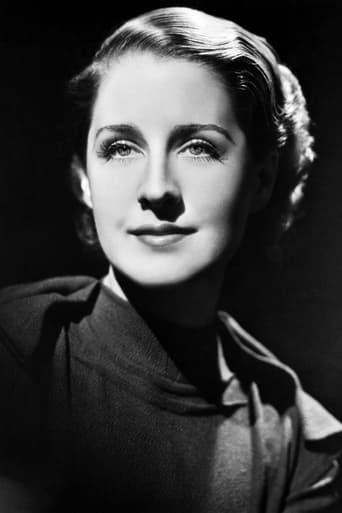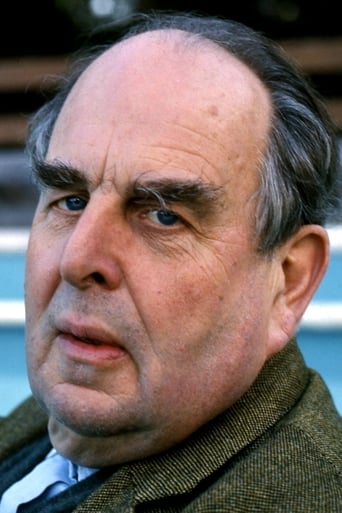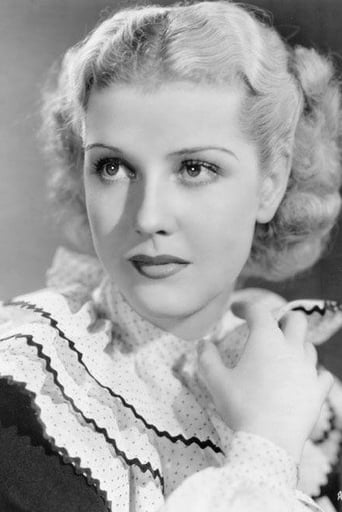Pluskylang
Great Film overall
Matialth
Good concept, poorly executed.
Odelecol
Pretty good movie overall. First half was nothing special but it got better as it went along.
Marva
It is an exhilarating, distressing, funny and profound film, with one of the more memorable film scores in years,
JohnHowardReid
The romance with Ty Power is a bit tedious, but fortunately it doesn't take up too much time. His role is smaller than usual. Not only does he make rather a late entrance, but he is by no means the male lead. His character definitely plays second fiddle to Robert Morley's. In Morley we have an actor who is extremely convincing. As the faltering, bumbling, incompetent yet ultimately sympathetic Louis XVI, Morley has his work cut out. Yet he makes it seem easy. Definitely his greatest portrayal. As for Marie Antoinette herself, this is of course a totally whitewashed characterization. Her famous line, "Let them eat cake!", is not even alluded to. Norma Shearer - in her first screen appearance since Romeo and Juliet, pulls out all stops to look radiant. Or rather cinematographer Daniels, costumer Adrian, her make-up man and hairdresser pull out all stops for her. Although not as blatantly miscast as her Juliet, Miss Shearer's Marie owes little to her own skills. If anything, her acting is far too theatrically old-fashioned to draw audience sympathy. Fortunately, Marie Antoinette is always absolutely dazzling to look at. The movie displays a sumptuousness, a richness, an elegance that far exceeds the visual extravagances we have come to expect of the usual M-G-M super-spectacle. The sets are absolutely breathtaking. So are the costumes. Even the special effects are truly marvelous. Van Dyke has directed it all with a certain amount of style, flair and confidence. True, his efforts are magnified by some wonderful performances. Morley as said, plus Barrymore, Schildkraut, George and company. A great roster indeed of Golden Age character players. What I particularly like about them here is that for once they don't look like Hollywood actors at all. No looking awkward and ill at ease in unaccustomed costumes and ill-fitting wigs. Director Van Dyke has happily integrated everyone into the action. What we have in Marie Antoinette are real people, rather than actors playing their customary mimes.The plot is strong too. Although it proceeds by fits and starts, lacking a cohesive narrative style, the story does maintain interest through a long running time right up to the final fade-out. Not all the glum-faced posturing of Mr Power nor the strident over-acting of Miss Shearer can long delay its pell-mell pace. The movie cost $1.8 million. None of that money has been wasted. The film has a sweep and a power that only the use of vast sets and the deployment of thousands of costumed extras could give. Here we have an historical spectacle so richly photographed in black-and-white that color seems both unnecessary and a liability. The music is effective too.
evanston_dad
The Queen of MGM plays the Queen of France in this opulent historical costume drama from 1938.Norma Shearer received her fifth and final Oscar nomination for playing the doomed Marie Antoinette, and boy does she earn it. She owns this movie, taking her character on an arc from giggly girl to wasted wretch and everything in between. Robert Morley received a supporting actor nod for his work as Marie's husband and King of France, and he's sensational as well. Perennial Oscar nominee Cedric Gibbons received a no-brainer of a nomination for the film's art direction, while Herbert Stothart rounded out its quartet of nominations for the original score.The film is long, but for the most part doesn't overstay its welcome. I say "for the most part" because of a plot line featuring Tyrone Power as Marie's love interest. This story grinds the film to a halt whenever it takes center stage and was clearly added as an obligatory bone to throw to the audiences who wanted some romantic swooning with their French revolution. Power has about as much personality as the statues that adorn the film's recreation of Versailles, and his whole story line could have been excised without harming the film in the least - - in fact, it would have been better because it would have been a good half hour shorter.Had a costume design category existed in 1938, "Marie Antoinette" would surely have been nominated and would likely have won.Grade: A
romanorum1
Marie Antoinette, born in 1755, a daughter of Austrian empress Maria Theresa, was 15 years old when she was told by her mother that she was to be betrothed to the French heir to the throne, the future Louis XVI. Maria Theresa's ultimate reason was to secure strategically the Austrian-French alliance in balance of power Europe. Marie was of course excited in a little girl sort of way. She was to leave home forever and travel to France with a small entourage (1770). The first meeting with Louis XVI was awkward, to say the least ("I like to be alone."). The king, although well-meaning and moral, was dull, fat and introverted; he was far too awkward to preside over a worldly-wise royal court. His main interest was in clock making and repairing. In fact, it was said that the marriage with Marie Antoinette was not consummated for quite a few years.The French court at Versailles was flamboyant, to say the least. There were gilded furniture, expensive paintings, and many amusements. (The movie itself is of lavish scope and sets.) Minuets were danced and childish games were played. The men were dandies: they had perfumed wigs, ruffled shirt cuffs, silk stockings and knee breeches (culottes). The women used heavy makeup, powdered their cheeks, wore jewelry, and had grand wigs and huge gowns that barely could cross an open doorway. Oh, their attire is something to behold! There certainly was no lack of intrigue and back-stabbing. In such a degenerate atmosphere the naïve Marie Antoinette was seduced; over time, Marie became known for her extravagance. France was really a rich country, but the good life was not shared. The French populace demanded attention to their wants; they were hungry and wore rags. They grumbled over the high taxes need to run the government, especially the court. Relief was not forthcoming for a variety of good reasons. After a series of scandals and odd events, especially the startling "Affair of the Diamond Necklace" (1785, see additional information below), the royal family's situation was doomed. On 14 July 1789 the fall of the Bastille to the uncouth and unwashed people began the two-year process whereby the king's power was first reduced then revoked entirely. Had he been smarter and sophisticated, the king may have been able to broker a deal that would have made him a constitutional monarch (instead of an absolute one). The people's leaders ran the courts, and they were none-too-merciful. The royal family was moved from the Palace of Versailles to the Tuileries Palace in Paris (1789). But after the royal family's failed escape (June 1791), they were housed in a Paris prison known as the Temple. First the king was stripped of his power, and then the queen's son was taken from her (he would mysteriously die in 1795 although his sister did live a long time). The last royal dinner in prison consisted of onion soup and bread; and the entire scene was heartbreaking. It occurred the night before the king's execution. First the king, then the queen, was guillotined (in 1793, about nine months apart); both did actually go to their deaths bravely. Count Axel Fersen survived and went back to Sweden; his end would come in 1810.Norma Shearer sympathetically portrays Marie Antoinette, and Robert Morley does the same for Louis XVI. The gorgeous Anita Louise plays the Princess de Lamballe, who, loyal to the royal family to the end, dies cruelly at the hands of a mob. Tyrone Power, Count Axel Fersen, was the loyal lover to the end who unsuccessfully engineers the escape of the royal family. John Barrymore portrays the unpopular and unlikeable Louis XV, who has the famous quote: "After me, the deluge." Joseph Schildkraut is the Duke of Orleans, an untrustworthy and ambitious radical who is in a powdered wig and heavy make-up. Gladys George is Madame du Barry, a putty-headed mistress who was later guillotined for treason (her inglorious end is not covered in the movie). Like other court mistresses she had no foresight to understand that her days were numbered once her king and benefactor died. BONUS INFORMATION ABOUT THE AFFAIR OF THE DIAMOND NECKLACE (an historical fact): The discredited adventuress, Countess de La Motte, duped Louis Cardinal de Rohan into believing he would regain his long lost court favor with Marie Antoinette if he would broker a deal for an extremely valuable necklace worth 1.6 million livres (originally intended for Louis XV's mistress, Madame du Barry). Mme. La Motte and her accomplices then engineered a sham correspondence between de Rohan and the queen. Mme. La Motte forged letters from the queen to Rohan attesting to her interest in the necklace. There was even a brief, sham meeting in the Gardens of Versailles between de Rohan and a woman impersonating the queen (the impersonator was really a prostitute). When de Rohan did obtain the necklace from the jeweler, he turned it over to Mme. La Motte. Her husband then took it to London where it was broken down and sold. The scandal became public when de Rohan, left on his own, could not make the payments on the necklace. De Rohan was acquitted of larceny although he lost his position in court. Mme. La Motte was found guilty and imprisoned, but later escaped. Unfortunately, as the affair came at a critical time in the reign of Louis XVI, Marie Antoinette was unjustly implicated by the French public. When the verdict of Rohan's acquittal was announced in the packed Paris Opera House in the presence of the queen, the crowds cheered as Marie Antoinette left in dismay (1786). Never again would she regain a semblance of public favor.
wes-connors
Indulgent MGM version of the life of "Marie Antoinette", as portrayed by Norma Shearer. The production is very beautiful looking, and well-performed. It is, however, excruciatingly long, and is without enough story embellishment to sustain interest; an even more fictionalized account might have been a wiser course of action. Ms. Shearer must be credited with crafting an vivid character; it's difficult, however, to feel much sympathy for her predicament, in this presentation. Robert Morley (as Louis XVI) elicits more sympathy, due to an almost oafish, but sensitive, portrayal; he is impressive, in his first feature film. John Barrymore (as Louis XV) and Gladys George (as du Barry) are among those delivering expert support. Particularly recommended for viewers with a longer life span than Marie Antoinette.******* Marie Antoinette (7/8/38) W.S. Van Dyke ~ Norma Shearer, Tyrone Power, Robert Morley, John Barrymore





